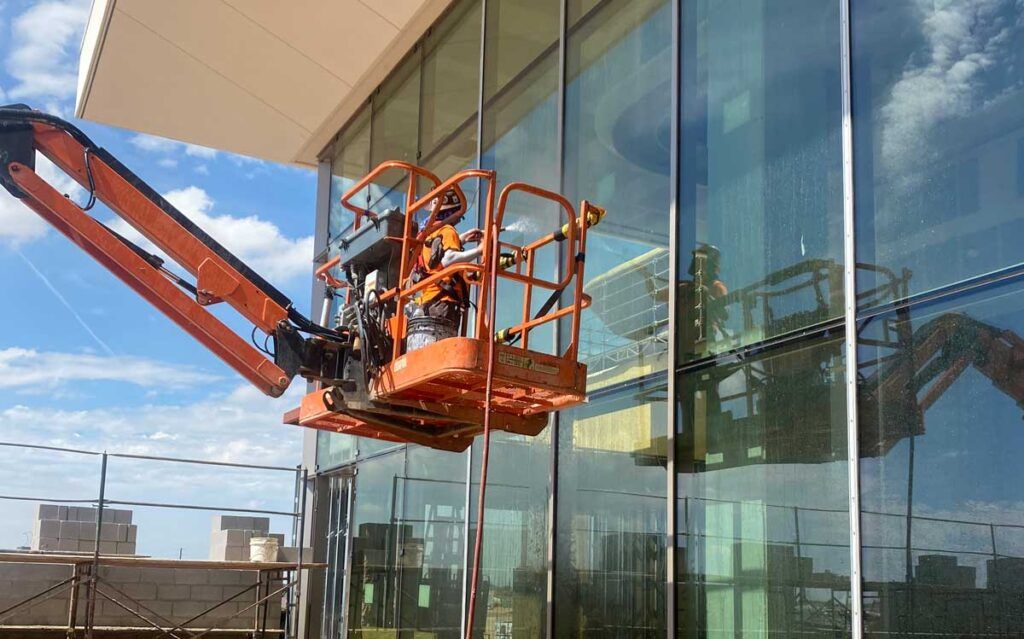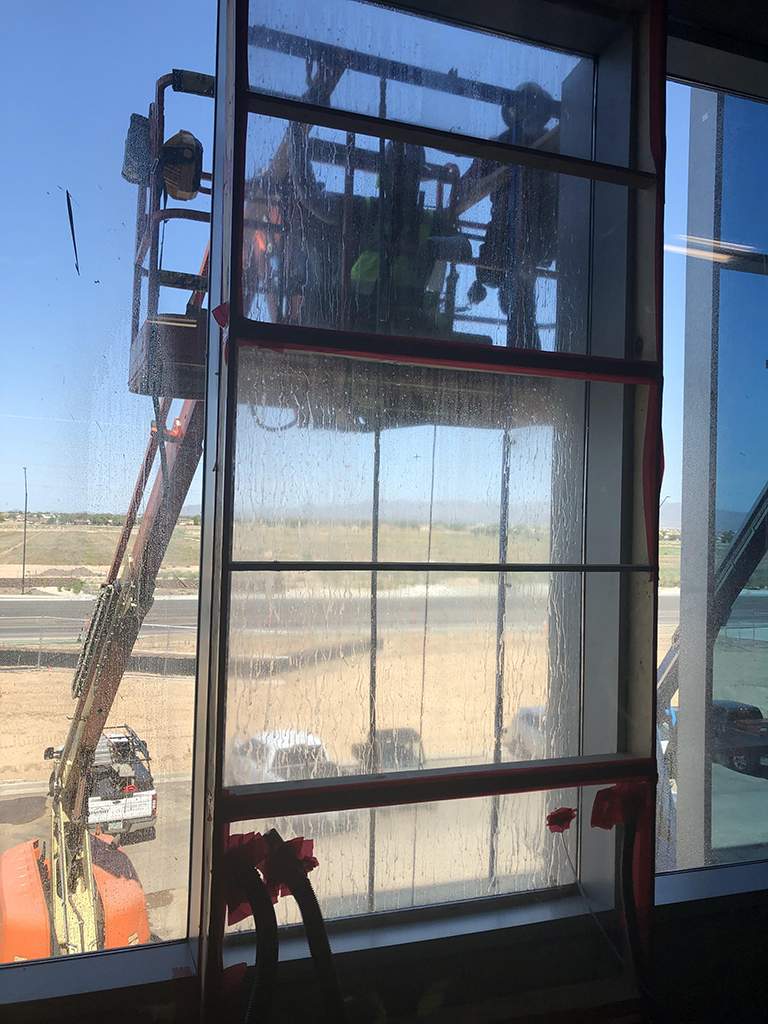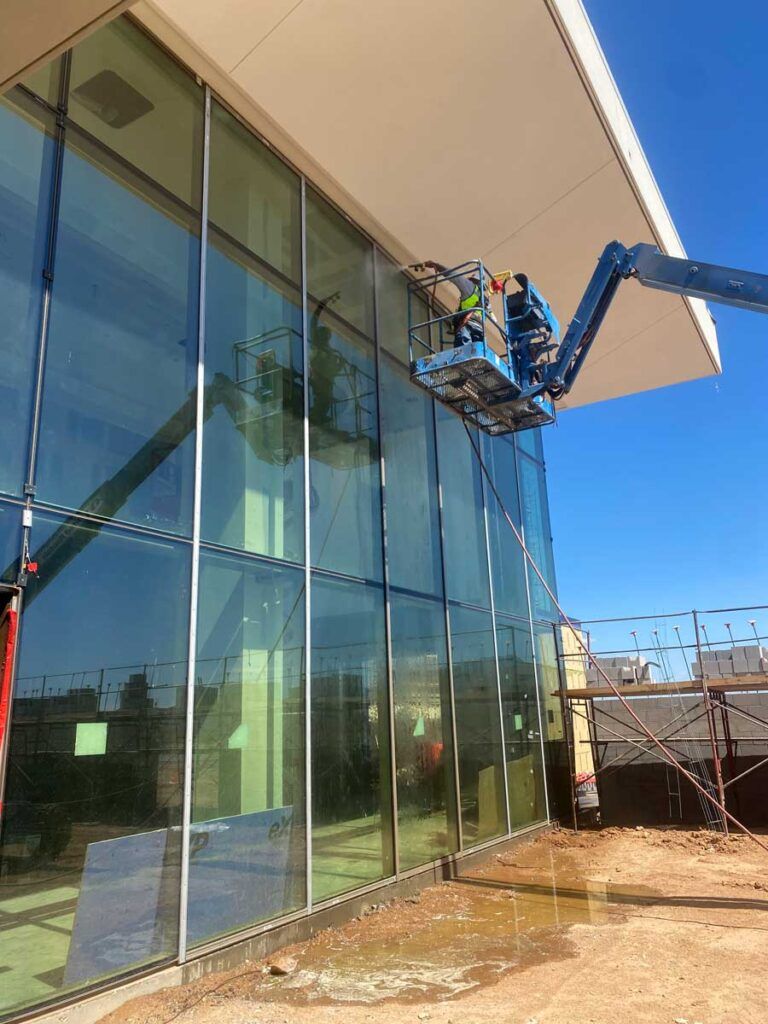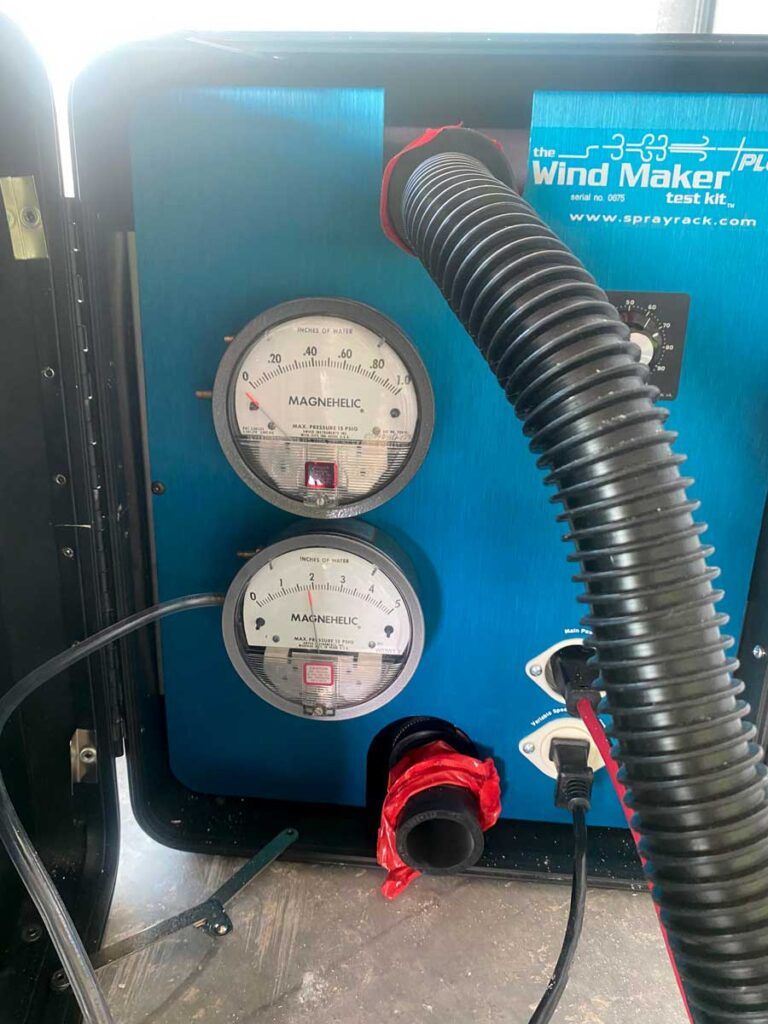The benefits of installing glass and curtain wall systems in commercial buildings are clear. Glass provides natural light and views of the outdoors from inside, and unique aesthetics for the building’s architecture and design on the exterior. These systems also play an important role in the energy efficiency of a building, as they can help regulate temperature and reduce the need for artificial lighting and heating/cooling.
Quality assurance (QA) and testing of glass and curtain wall systems are essential to ensure that these systems perform as intended and meet all safety requirements. This includes testing for structural integrity, air and water infiltration, thermal performance, wind load testing, and acoustic insulation. QA and testing are achieved through a combination of lab testing, computer modeling, and field monitoring.

How Testing is Performed
Lab testing includes the use of physical models or “mock-ups” — smaller versions of the exterior wall systems – to simulate real-life conditions and analyze the performance of the glass and curtain wall systems. This allows for potential issues to be identified and addressed before construction or installation, ensuring a successful outcome. Models can also be helpful in determining the most effective design solutions for energy efficiency and meeting building codes and regulations.
Computer modeling is also used in QA and testing for glass and curtain wall systems, as it allows for virtual simulations of the building’s performance under various conditions. This can inform design decisions and identify potential issues before construction or installation.
Field monitoring involves ongoing checks and inspections during and after installation to ensure that the glass and curtain wall systems continue to perform as intended. This may include checking for water leaks, air infiltration, and structural integrity over time.
Most of the testing performed on our Giroux Glass projects takes place in a lab, and is typically conducted by a third-party, professional testing facility. “Using an outside company enables us to present unbiased, objective results to our customers and to all interested stakeholders,” explains Kelly Edwards, Giroux Glass director of CA facilities and field operations. Companies we have used for testing include Intertek (Fresno); Construction Consulting Laboratories, (CCL) West (Montclair, CA, and Dallas, TX); and Field Verified (Mesa, AZ)
Visual Inspection
We consider visual inspection to be an important aspect of QA testing for glass and curtain wall systems. This includes checking for any signs of damage or wear, such as cracks or gaps in the glass or misalignment of panels. We inspect seals and joints for proper sealing to prevent air and water infiltration. Any defects or issues found during visual inspection are immediately addressed to ensure the safety and performance of the glass and curtain wall systems.
Air and Water Tightness
Air and water tightness testing are crucial for ensuring the proper functioning of glass and curtain wall systems. This can involve pressurizing the system to simulate weather conditions, and checking for any leaks or infiltration. Proper sealing of joints and panels is essential in preventing unwanted air and water flow, as well as potential damage to the building’s interior.
At Giroux Glass, we subject our curtain wall systems to a variety of tests to identify very specific areas for potential system failures. We perform these tests as soon as we complete the installation and caulking on the first few openings and while the interior walls are still unfinished, so that we can see any vulnerability or moisture caused by testing. This enables us to immediately correct any issues before the building is completed.
We include field tests recommended by the “AAMA 502” (Voluntary Specification for Field Testing of Newly Installed Fenestration Products) as a set of guidelines, as established by the American Society for Testing and Materials (ASTM) International:
- ASTM E 783 is a procedure to determine if any air is leaking through exterior windows and doors into the interior.
- ASTM E1105 is a test in which water is applied to the outside with a spray rack, while on the inside a specially-designed wood chamber around the windows creates negative pressure to confirm that no water penetrates.
- AMMA 501.2 is a test for storefronts, curtain walls and other glazing systems in which large units of glass stay permanently closed. This test sprays large volumes of water to the exterior, through a ¾” hose with a ½” diameter nozzle at 35 psi from one foot away to confirm that the glass surface and all of its edges and joints are watertight.
Rob Felice, Giroux Glass production QA QC manager, says, “If there is a pinhole anywhere within the testing area, our test procedures will absolutely find it.”
Wind Load
Wind load testing is also important in determining the strength and stability of glass and curtain wall systems, particularly in areas prone to high winds or extreme weather events. Performed in a lab, these tests simulate wind conditions and measure the pressure exerted on the system to ensure it can withstand such forces without failure. Wind load testing should be conducted in accordance with local conditions, building codes and regulations to ensure safety. These tests include:
- ASTM E 330: a standard procedure for determining structural performance under uniform static air pressure difference. This typically is intended to represent the effects of a wind load on exterior building surface elements.
- AAMA 501.1: a standard test method for water penetration using dynamic pressure, on windows, curtain walls and doors
- AMMA 501.4: a static test method for evaluating window wall, curtain wall and storefront systems subjected to seismic and wind-induced inter-story drift
- AMMA 501.7: a recommended static test procedure for evaluating windows, window wall, curtain wall and storefront systems subjected to live load, vertical inter-story movements

Thermal Cycling
Also performed in a lab, thermal cycling testing involves exposing the system to extreme temperature variations, simulating real-life conditions and analyzing its performance. This can help identify any potential issues with insulation or energy efficiency, as well as checking for proper sealing to prevent air leakage.
In addition, thermal cycling testing also determines whether the glass and curtain wall systems can withstand temperature fluctuations without failure or cracking. The test most commonly used for this type of system performance is AMMA 501.5: thermal cycling of exterior walls.
Energy Efficiency
Energy efficiency testing is important in determining the effectiveness of glass and curtain wall systems in regulating temperature and reducing energy usage. This can involve measuring insulation properties and analyzing the performance of integrated technologies, such as solar control glazing or automated shading systems. QA testing can also help identify any potential air leakage, which can significantly impact a building’s energy efficiency.
Acoustic Insulation
Glass and curtain wall systems can also play a role in acoustic insulation, reducing noise transmission between interior spaces and the external environment. Acoustic testing involves measuring the sound transmission through the system, as well as analyzing any potential structural resonances that could amplify noise. QA testing can help ensure that the glass and curtain wall systems provide adequate acoustic insulation for the building’s needs. The test we use to determine the acoustical rating of exterior windows, doors, skylights and glazed wall sections is AMMA 1801-13.
Work With Trusted Professionals
At Giroux Glass, we recognize that QA testing is essential in ensuring the safety and performance of glass and curtain wall systems. It can identify potential defects or issues, as well as verify compliance with building codes and regulations. Working with trusted glazing professionals can ensure that all QA testing is performed effectively and accurately, as they have the knowledge and expertise necessary to properly conduct these tests. They can also provide valuable insight into potential design solutions, ensuring compliance with building codes and regulations.



